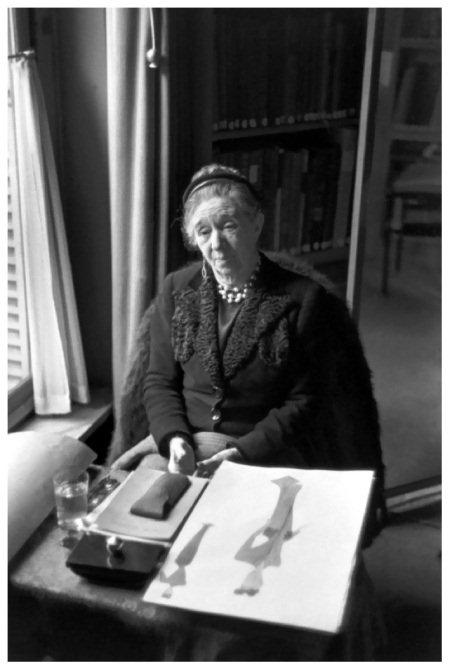

Nowadays Alber Elbaz does a fantastic job as head of Lanvin, but it all started with Jeanne Lanvin, the founder of the house of Lanvin. The grande dame was one of the greatest and least-know designers of the 20th century.
.
Biography

Jeanne-Marie Lanvin ( 1 January 1867, Paris – 6 July 1946, Paris) was the eldest of 11 children. She trained as a dressmaker at a French fashion house called Talbot and then later worked as a milliner. She had the passion, unique talent, energy and enormous potential. In 1890, backed by a devoted client, she opened up a millinery shop (Coco Chanel also started as a milliner and opened a millinery shop, before she went into fashion design).
Jeanne Lanvin, who by now was a doting mother, also designed an extensive mini-me wardrobe for her daughter Marguerite Marie-Blanche di Pietro. She made such beautiful clothes for her daughter, using sophisticated textiles and colours, that they began to attract the attention of a number of wealthy people who requested copies for their own children and Jeanne branched out into childrenswear.






.
Marguerite was the inspiration and driving force behind Lanvin’s designs. Jeanne created the looks of eternal youth, so that her daughter was the most beautiful woman in the world. Designing dream outfits that her daughter could wear gave Lanvin a chance to relive her own life as she’d always dreamed of. The life she had to sacrifice to her work.
Following customer demand for adult versions of her exquisite children’s clothing, she created women’s and girls’ lines. Her first garments follow the simple, Empire-waisted chemise silhouette. As a full-fledged couturière, she now joined the Chambre Syndicale de la Couture and becomes known for her mother-and-daughter outfits.
.
The Lanvin logo


(The Lanvin logo is inspired by a picture of Jeanne and her daughter Marguerite.)
.
Jeanne was in her fifties when she became famous for her designs for grown-ups and was not like her rival, Coco Chanel, designing for slim women, but continued her bouffant style for women with a larger size, like Paul Poiret did. The robe de style bouffant dress became her signature piece.
Jeanne loved to work with expensive fabrics and her garments were easily recognisable for her masterful use of embellishment, her delicate trimmings and her embroideries along with exquisite beadwork in floral inspired colours. Often her embellishments included free-flowing ribbons, ruffles, flowers, lace or mirrors inspired by her travels. Ornamentation included appliqué, couching, quilting, parallel stitching, embroidery and discreet use of sequins.






Jeanne’s clothes were about perfection. She chose the fabrics, then developed her own colour schemes and even built a dye factory in Nanterre in 1922 to achieve the subtle inimitable shades she was after. She used pieces of mica, coral, minute shells, gold and silver threads, ribbons and raffia along side of pearls and sequins, so that the beading would match the fabric, the mood and the motif. Fabrics most often used were silk, taffeta, velvet, silk chiffon, organza, lace, fur and tulle.
Unlike her rivals Coco Chanel, Paul Poiret or Elsa Schiaparelli, Jeanne Lanvin was a very private person – she would rather stay on background than dissolve herself into the lights of fame and social glamour. Dressed in black, she was more keen on concentrating on her designs and communicating with fabrics rather than people.
This was also the problem, Jeanne Lanvin had no public image and no public relations in the industry. Her rivals all understood that they needed to embody their house in their own appearance, so they were tireless self-promoters. Karl Elberfeld wrote about Jeanne: “Her image wasn’t as strong as that of Chanel because she was a nice old lady and not a fashion plate”.




On the other hand, Jeanne was a great businesswoman and 1918 she took over the whole building at 22 Rue du Faubourg Saint-Honore. It included two workrooms for semi-tailored clothes, two for tailored ones, one for lingerie, one for hats, one that was used as a design studio, and two that were given over to embroidery; the latter was a speciality which Lanvin, unlike other couturiers, did not entrust to outside workers.
And Jeanne did understand that fashion isn’t just about clothes, it is a way of life and in the 1920s she already opened shops devoted to home décor (Lanvin Décoration, at 15 Rue du Faubourg Saint-Honoré), sportswear, menswear, furs, swimwear and lingerie. Lanvin became the first house to dress the whole family!

In 1924, Jeanne was one of the first couturiers to create a division for fragrances, Lanvin Parfums and the next years a fragrance factory is constructed near Nanterre. Mon Peche scent debuted, but didn’t do so well untill the name was changed into My Sin. In honor of Marguerite’s (who, by then, calls herself by her middle name: Marie-Blanche) 30th birthday Arpege, lanvin’s first perfume, debuted. Later many new fragrances followed, like Scandal, Eau de Lanvin and Rumeur.
During WWII, Jeanne continued to operate her house, creating special collections for women engaged in war work and regulation uniforms for female armed-service members.
Jeanne Lanvin’s Art Deco appartement

“When you are constantly thinking about new designs everything you see is transformed and adapted to whatever is in hand. The process happens naturally and becomes an instinct, a truth, a necessity, another language.”
.
.
In 1946, Jeanne Lanvin died at age 79. her daughter, Marie- Blanche de Polignac took ownership until she herself passed in 1958, and the house of Lanvin went to their cousin Yves Lanvin. From then on the label passed from hand to hand. By the time Alber Elbaz took over in 2002 it was the oldest fashion house in continuous operation, and despite its dimmed reputation, it somehow survived and overnight became a huge success again!

.
Books on Jeanne Lanvin

http://www.assouline.com/lanvin.html
.

www.amazon.com
.



